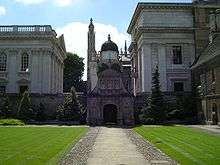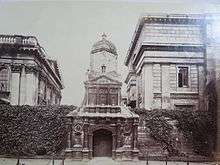John Caius
| John Caius | |
|---|---|
 | |
| Born |
6 October 1510 Norwich, England |
| Died |
29 July 1573 (aged 62) London, England |
| Nationality | England |
| Fields | Medicine |
| Institutions | Gonville and Caius College, Cambridge |
| Alma mater | University of Padua |
John Caius MD (born John Kays) (/ˈkiːz/;[lower-alpha 1] 6 October 1510 – 29 July 1573), also known as Johannes Caius and Ioannes Caius, was an English physician, and second founder of the present Gonville and Caius College, Cambridge.
Biography
Early years
Caius was born in Norwich and was educated at Norwich School.[1] In 1529 he was admitted as a student at what was then Gonville Hall, Cambridge, founded by Edmund Gonville in 1348 - where he seems to have mainly studied divinity.
After graduating in 1533,[2] he visited Italy, where he studied under the celebrated Montanus and Vesalius at Padua. In 1541 he took his degree as a physician at the University of Padua.
In 1543 he visited several parts of Italy, Germany and France and then returned to England. Upon his return from Italy he Latinised his surname, an action which although self-aggrandising, was somewhat fashionable at the time.
Career


Caius was a physician in London in 1547, and was admitted as a fellow of the College of Physicians, of which he was for many years president.
In 1557 Caius, at that time physician to Queen Mary, enlarged the foundation of his old college, changed the name from "Gonville Hall" to "Gonville and Caius College," and endowed it with several considerable estates, adding an entire new court at the expense of £1,834. He accepted the mastership of the college 24 January 1559 on the death of Dr Bacon, and held it until about a month before his own death.

He was physician to Edward VI, Queen Mary and Queen Elizabeth. From this position he was dismissed in 1568 on account of his adherence to the Roman Catholic faith. He was incongruously accused both of atheism, and of keeping secretly a collection of ornaments and vestments for Roman Catholic use. The latter were found and burned in the College court.
He was elected nine times president of the College of Physicians, an account of which, Annales collegii medicorum 1520-1565, he left in manuscript.
He returned to Cambridge from London for a few days in June 1573, about a month before his death, and resigned the mastership to Thomas Legge, a tutor at Jesus College. He died at his London house, in St Bartholomew's Hospital, on 29 July 1573, but his body was brought to Cambridge, and buried in the chapel under the monument which he had designed.
The question of whether John Caius was the inspiration for the character of Dr Caius in Shakespeare's play the Merry Wives of Windsor has been discussed at length by Arnold McNair, 1st Baron McNair.[3]
Legacy
Caius was a learned, active and benevolent man. In 1557 he erected a monument in St Paul's Cathedral to the memory of Thomas Linacre. In 1564, he obtained a grant for Gonville and Caius College to take the bodies of two malefactors annually for dissection; he was thus an important pioneer in advancing the science of anatomy. He probably devised, and certainly presented, the silver caduceus now in the possession of Caius College as part of its insignia. He first gave it to the College of Physicians, and afterwards presented the London College with another.
Works
Caius was also a pioneer naturalist, prepared to make his own observations about nature rather than simply relying on accepted authorities. He was ready to make journeys about the country to see and record unusual animals. As such he could be considered also a pioneer of Zoology, not yet recognised as a separate science.
He corresponded with the Swiss naturalist Conrad Gesner, with whom he had made friends while returning from Padua. He wrote a study of British dogs to send to Gesner as a contribution (not used) to his Historiae animalium, and also sent him drawings of dogs, which were printed in later editions of Gesner's work.[4] Caius' Catholic religious convictions did not prevent his friendship with the Protestant Gesner (indeed, the Historiae Animalium, to which Caius contributed, was under Pope Paul IV placed on the Roman Catholic Church's list of prohibited books).[5]
His last literary production was the History of Cambridge University, Historia Cantabrigiensis Academiae (London, 1574).
See also
- Thomas Caius, Master of University College, Oxford (1561–1572)
- Bloodhound
Bibliography
| Wikisource has original works written by or about: John Caius |
- Annals of the College from 1555 to 1572
- translation of several of Galen's works, printed at different times abroad.
- Hippocrates de Medicamentis, first discovered and published by Dr Caius; also De Ratsone Vicius (Lov. 1556, 8vo)
- De Mendeti Methodo (Basel, 1554; London, 1556, Svo)
- Account of the Sweating Sickness in England (London, 1556, 1721), (it is entitled De Ephemera Britannica)
- History of the University of Cambridge (London, 1568, 8vo; 1574, 4to, in Latin)
- De Thermis Britannicis; but it is doubtful whether this work was ever printed
- Of Some Rare Plants and Animals (London, 1570)
- De Canibus Britannicis (1570, 1729)
- De Pronunciatione Graecae et Latinae Linguae (London, 1574)
- De Libris propriis (London, 1570).
- Of Englishe Dogges: The Diuersities, the Names, the Natures, and the Properties (London, 1576).
Notes
- ↑ Caius is a Latinized version of Kees or Keys
References
- ↑ Bayne, A. D. (1869). A Comprehensive History of Norwich. Jarrold and Sons. p. 726.
- ↑ "Caius, John (CS529J)". A Cambridge Alumni Database. University of Cambridge.
- ↑ Lord McNair, Why is the doctor in the Merry Wives of Windsor called Caius?, Med Hist. 1969 October; 13(4): 311–339; online at Medical History page.
- ↑ Ash, Edward C. Dogs: their History and Development. Ernest Benn Ltd, London 1927
- ↑ "Conran Gesner biography". Retrieved 2008-09-17.
![]() This article incorporates text from a publication now in the public domain: Chisholm, Hugh, ed. (1911). "Caius, John". Encyclopædia Britannica (11th ed.). Cambridge University Press.
This article incorporates text from a publication now in the public domain: Chisholm, Hugh, ed. (1911). "Caius, John". Encyclopædia Britannica (11th ed.). Cambridge University Press.
Further reading
- For further details see the Biographical History of Caius College, by Dr John Venn (1897).
- Caius, John, A Boke or Counseill against the Disease Called the Sweate, London 1552. Facsimile ed., 1937, Scholars' Facsimiles & Reprints, ISBN 978-0-8201-1182-7.
- Nutton, V (1985). "John Caius and the Eton Galen: medical philology in the Renaissance". Medizinhistorisches Journal. 20 (3): 227–52. PMID 11616032.
- Nutton, V (October 1979). "John Caius and the Linacre tradition". Medical History. 23 (4): 373–91. doi:10.1017/s0025727300052030. PMC 1082578
 . PMID 390265.
. PMID 390265. - Cooke, A M (July 1973). "Dr John Caius, 1510-1573". Journal of the Royal College of Physicians of London. 7 (4): 365–71. PMID 4577633.
- ALBERTI, F (October 1961). "Anatomy in London. Anatomic teaching in London and John CAIUS, student of the Padua School before Harvey". Minerva Med. 52: Varia 1893–6. PMID 13860128.
- O'MALLEY, C D (April 1955). "The relations of John Caius with Andreas Vesalius and some incidental remarks on the Giunta Galen and on Thomas Geminus". Journal of the history of medicine and allied sciences. 10 (2): 147–72. doi:10.1093/jhmas/X.2.147. PMID 14367793.
- WOHLFARTH, P (December 1954). "[John Caius and his time.]". Deutsches medizinisches Journal. 5 (23-24): 689–93. PMID 14352903.
Offices Held
| Academic offices | ||
|---|---|---|
| Preceded by Thomas Bacon |
Master of Gonville and Caius College 1559–1573 |
Succeeded by Thomas Legge |
External links
- John Caius on the Gonville and Caius College website
- Works by John Caius at Project Gutenberg
- Works by or about John Caius at Internet Archive